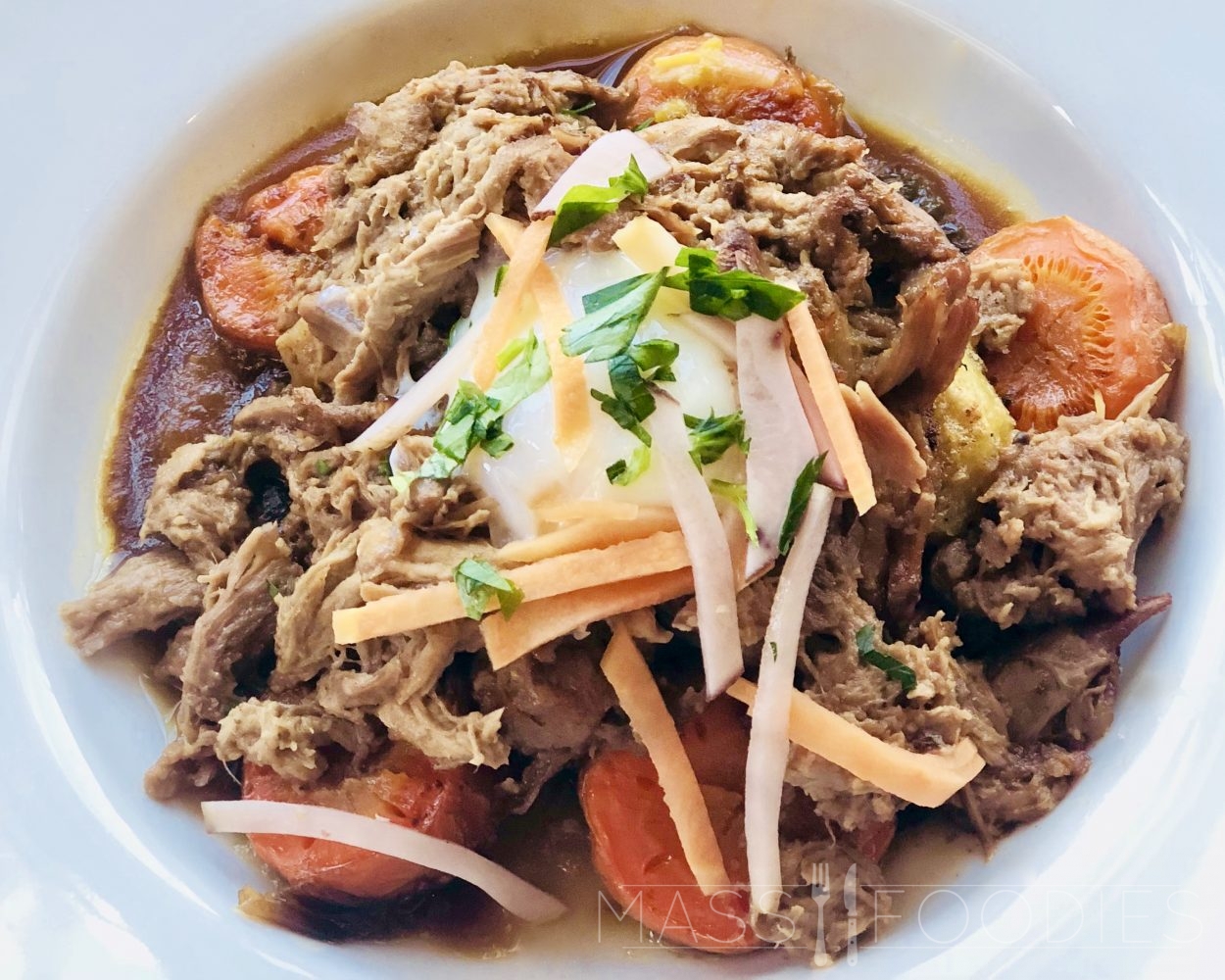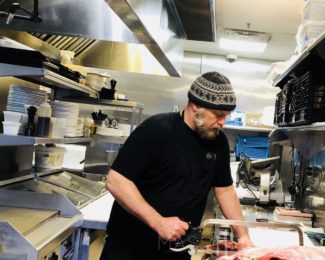
On a late-winter morning, I found myself standing outside 144 Main Street at 6:58 a.m., tapping on the kitchen window of Armsby Abbey. Executive Chef Sean Dacey was fit to butcher a 29 lb. lamb and I hadn’t even had my coffee yet.
He opened the door and then disappeared into the walk-in where he fetched Ram, the one year old lamb that had arrived from Chimney Hill Farm the day before. “There’s a growing acknowledgement that we need to be using the whole animal. Everyone’s squeamishness about this kind of thing is dissipating,” Dacey told me.
A lot of the Abbey’s animals come with names, a simple consequence of the fact that Dacey maintains close relationships with his farmers.
“It can be emotional for farmers,” Dacey said, recalling Walker Farm’s prize steer, George. “George had grazed seasonally, rotating through Joanie Walker’s fields to maintain the health of her soil. She gave us George and then came in to eat him because she trusted us,” he explained.
Dacey takes particular pride and care when cooking with older animals.
“In the factory farming system, older animals are generally viewed as a negative. But, we know that animals that live full lives and get pastured have amazing qualities. Joanie Walker takes three times longer to raise her cows than most farmers and that’s more expensive for her,“ explained owner Alec Lopez.

Walker’s visit to Armsby Abbey for her final farewell to George was not unusual for the establishment. Influential brewers, chefs, and farmers have flanked to the Abbey to enjoy the fruits of their labor (sometimes literally) since it opened nearly a decade ago. Regardless of whether a respected farmer or a first time customer sits down at a table, Dacey expects his staff to be more than just knowledgeable. The restaurant’s table management system, Reserve, certainly helps. The system allows staff to monitor and maintain customers’ visits, dining habits, dietary restrictions, allergies, and requests. If a farmer is coming in for a special goodbye, you can be sure there’s a note in Reserve so that his or her server can be briefed.
Gazing at the primal cuts of Ram (the lamb) in the early morning light, I asked Dacey, “How much is your front of house team expected to know about what goes on back here?”
“Everything,” he responded.
On Sunday, I returned for brunch, this time on the other side of the pass. The general layout at 144 Main Street is curious in that the kitchen is located across the hall from Armsby Abbey’s dining room.
I could tell that Dacey was not exaggerating about the awareness of his staff. Our service was nothing short of remarkable. I ordered the stout braised lamb served with seared mashed potatoes and a rolled oat cake, and topped with smoked turnip puree, butter braised carrots, pickled potatoes, and a soft-cooked egg. Ram tasted just as handsome as he looked.
On Monday night, Dacey invited me back once more to attend a staff meeting about primal cuts and charcuterie. At the Abbey, weekly meetings provide key opportunities for interpersonal moments between the kitchen and the front of house. During a busy service, much of the communication among these two parties takes place with iPads and pagers. “Armsby utilizes a dual iPad system that runs Reserve; meaning our host station and our kitchen run the app simultaneously for real time information,” owner Sherri Sadowski explained, “without Reserve, the only window into how busy the dining room is, is via the tickets streaming from the printer.”
Armsby Abbey attracts an eclectic crowd. “During a busy dinner service, Reserve allows the kitchen to see what kind of night it is; be it a date night where the room is filled with deuces or more of a rowdy atmosphere where the dining room is overflowing with larger parties. Every shift is different and Reserve allows the kitchen to keep tabs on exactly how the shift will play out,” Sadowski shared.
On Monday nights, Dacey is free to move at an easier pace. It’s technically his day off, but he finds these gatherings too important to neglect. Dacey wants his team to be knowledgeable enough to sell his most unconventional dishes because he views them as not only exquisite, but also humane. Above anything else, Armsby Abbey’s kitchen strives to run with patience – a constant struggle in an industry where things seem to move at full tilt.
Dacey began the training by reminding his staff, “At your pre-shift meetings on Fridays and Saturdays, there is time to relay information, but no time for nuance. That’s why we’re all here tonight.”
Lopez and Dacey went on to recall a workshop with butchery legend, Adam Danforth, at the Chefs Collaborative Summit last summer during which Danforth broke down an 11 year old lamb and cooked the cuts on ripping hot cast iron for immediate consumption. The experience accentuated flavors rendered from working muscles, affirming the decision that the Abbey has made to support farmers by taking on older animals like George. This practice began with previous Executive Chef Damian Evangelous who departed in March for the west coast.
When the meeting concluded at 10:30 p.m., I watched a few members of the staff hang back to ask Dacey and Lopez questions. Others thumbed through a copy of Danforth’s book and nibbled at what was left of the head cheese. At 11:00, when Dacey felt sure the staff was prepared, he finally defected to get some sleep for a few precious hours. I can’t help but suspect that he even cooks in his dreams.
